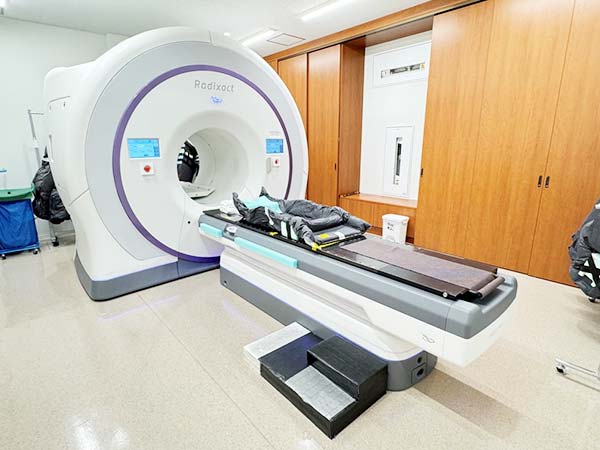The Radiology Department is staffed by 3 full-time radiologists, 15 part-time physicians, 41 radiologic technologists, and 1 administrative staff member. The main diagnostic and treatment equipment includes 3 CT scanners, 2 MRI machines, 4 angiography units, 3 X-ray fluoroscopy units, 1 nuclear medicine device (RI), 1 PET-CT scanner, 6 ultrasound machines, and 1 linear accelerator.

Radiology
About Us
Imaging Diagnostics Center
We focus on comprehensive imaging diagnostics (including plain X-rays, ultrasound, CT, MRI, and angiography) and strive to provide high-quality diagnostic information to the attending physicians as quickly as possible. For tests requested by other hospitals, we promptly send the imaging findings via fax. We have a 24-hour system in place to handle emergency examinations, and MRI tests can be scheduled even on holidays.
In addition, we are actively engaged in Interventional Radiology (IVR) procedures, such as arterial embolization for liver tumors, gastrointestinal bleeding, hemoptysis, and trauma-related bleeding, transcatheter venous embolization for gastric varices, intra-arterial chemotherapy for cancer, reservoir placement procedures, and CT-guided biopsies.
TomoTherapy – Radixact™ System
We have introduced the advanced high-precision radiation therapy device,
the **TomoTherapy – Radixact™ System**.
Targeting only cancer cells, offering
body-friendly cancer treatment.

Tomo Helical™
Continuous rotation radiation (helical irradiation) enables treatment of complex-shaped tumors.
Tomo Direct™
Stationary gantry radiation (direct irradiation) allows for versatile treatment options.
Therapy Process
1. Consultation
After receiving a referral, a specialist will examine you. They will determine whether radiation therapy is appropriate, and if so, the treatment plan will be discussed.
2. Treatment Planning
A CT scan for treatment planning is conducted. The results are analyzed, and based on this, an optimal treatment plan is created. (In some cases, additional CT scans may be necessary.)
3. Treatment
To administer the treatment precisely, the positioning of the body is adjusted using the CT scan to ensure accurate irradiation. (The procedure is painless.)
4. Consultation
Depending on the treatment plan, treatment sessions are typically scheduled 1-2 times per week. Follow-up consultations will be conducted to monitor progress.
5. Post-Treatment Care
After radiation therapy, ongoing management and monitoring of the condition are essential. If necessary, further consultations or follow-up treatment may be arranged.
Features of This Device
- The ring-shaped gantry with minimal pressure sensation allows for comfortable treatment.
- The fan-beam CT imaging captures the tumor’s position accurately during each treatment.
- The high-speed, binary MLC (multi-leaf collimator) enables focused treatment on the tumor.
- Our facility performs radiation therapy without attaching markers to the skin.
FAQ
What are the advantages compared to previous radiation therapy?
By focusing the radiation precisely on the tumor, it minimizes damage to surrounding healthy tissue, reduces side effects, and enables more body-friendly radiation therapy.
Can TomoTherapy treat any type of cancer?
It depends on the type and location of the cancer, but it can treat many types. TomoTherapy is particularly effective for cancers such as head and neck cancers, brain tumors, and bone metastases.
Do I need to be hospitalized for TomoTherapy?
In some cases, hospitalization may be necessary, but most people can receive outpatient treatment.
Is there any pain during the treatment?
There is no pain from the radiation itself, but side effects may occur as the number of sessions increases.
What kind of side effects can occur with radiation therapy?
Side effects vary depending on the treatment site, but they can include headaches, nausea, skin reactions, and fatigue. However, TomoTherapy tends to have fewer side effects compared to traditional radiation therapy. If you experience any concerns, please consult your doctor immediately.
What should I be mindful of during the treatment period?
It’s important to maintain a balanced lifestyle. Avoid intense exercise, stay hydrated, and get plenty of rest. Depending on the treatment site, skin reactions may occur, so be gentle with your skin and avoid using harsh soaps or creams.
Radixact™
Radixact is the latest radiation therapy system equipped with a radiation therapy device (LINAC) and CT (Computed Tomography) imaging capabilities.
Tumor-specific focused treatment
High-speed binary MLC (Multi-Leaf Collimator) enables focused treatment on the tumor.
Open hardware concept
The ring-shaped gantry with minimal pressure sensation allows for comfortable treatment.
Accurate tumor position verification
Fan-beam CT imaging captures the tumor’s position accurately during each treatment.
Simultaneous treatment over a wide area
By moving the patient smoothly, multiple tumors can be treated with a single setup. It can cover a wide area up to 40 cm x 135 cm.
Find Doctors
Hirohiko Tanihata M.D.
谷畑 博彦
- Title
- Chief, Department of Radiology
- Specialty
- ・Radiologyist
・Radiation therapy
・Diagnostic imaging
・Interventional Radiology (IVR)
・Mammography screening interpretation
Akihiro Kojima M.D.
小嶋 章裕
- Title
- Deputy Chief, Department of Radiology
- Specialty
- – Radiologyist
Shota Ueda M.D., Ph.D.
植田 昇太
- Specialty
- ・Radiologist
・Diagnostic Radiologist
・Diagnostic Imaging / Interventional Radiology (IVR)
・Nuclear Medicine Specialist
・PET Nuclear Medicine
・Mammography Interpreter
・CT Lung Cancer Screening Interpreter
